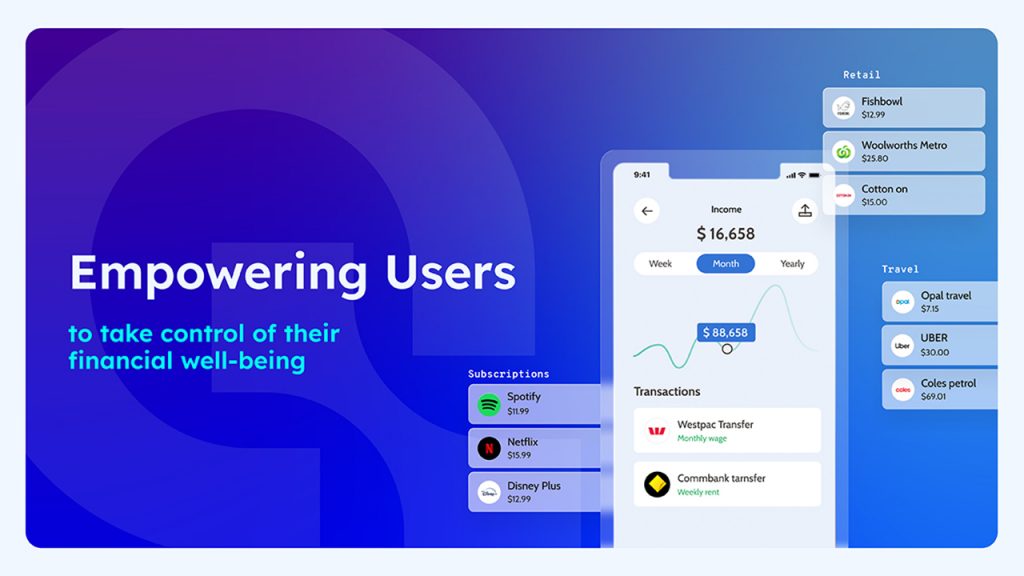In July, we composed a comprehensive white paper examining the rollout of Open Banking to date, suggesting we are embarking on a journey toward Open and Embedded finance. This was done through highlighting four novel use cases for Open Banking’s future. This post will give you a sneak peek on three of the most compelling use cases from the paper. (if you’d like the full paper and the extra use case, you can find it here).
Use Case 1 – Sustainability Scoring for Fintechs
Visa’s sustainable banking report finds that consumers are demanding four pillars of sustainability within their banking experience: understanding their carbon footprint, offsetting their environmental impact, incentivising behavioural change & anchoring their impact on the world.
A novel use case is that of carbon calculation based on merchant identifiers. For example, the Australian software developer Avarni – a Basiq partner – derives a carbon calculation index based on transaction data, once the user has consented to share their data with the Avarni API. This allows for the generation of a ‘carbon score’, which means consumers can see how environmentally friendly their purchases have been. Some businesses are even using this to nurture loyalty to green brands, using an aggregation of green brands as a merchant acquisition tool. It allows businesses to increase customer engagement, gain top of wallet preference, tap into incremental revenue streams and retain and acquire customers. Basiq customers can access accurate carbon-emissions data and provide these insights to their end users through one API.
Use Case 2 – Rules and Event Based Payment Initiation
One of the most common use cases in the UK, an early adopter of Open Banking, is combining payments and data. Under PSD2 in Europe, this is known as the interaction between Account Information Service Providers (AISPs) and Payment Initiation Service Providers (PISPs). Or, to put it more plainly, the relationship between an account aggregator (e.g. Basiq) and a payments provider (e.g. Split Payments). This allows for actions to occur based on a change in transactional data state, for example.
Australia is yet to see the full potential in marrying these two concepts. Indeed, there is a likelihood that the consent flow to authorise payment initiation should occur in conjunction with data consent to make for a seamless user experience. The following use case is an example of how rules-based payments could potentially be implemented by Australian consumers:

Create condition: When I shop at McDonald’s, transfer $5 into my gym membership account
Create event: Transfer of $5 to gym account every time a transaction occurs at McDonald’s
Capture consent: Authorise the transfer of money from a merchant that detects shopping at McDonald’s (via enrichment) and then transfer that to my gym membership account
Condition: McDonald’s is shopped at
Event: Gym account is topped up
Consent: Ongoing until next condition is satisfied
There are many use cases where payments and data can be combined. For example, you can combine payment and data to smooth bills. Of course, taking the friction out of paying for subscriptions is just the beginning. With a consent-driven rules engine it is, for instance, straightforward to have a percentage of your salary go towards buying equities every time you get paid.
Use Case 3 – Dynamic Credit Risk Decisioning
Consent can be captured as a one-off to determine likelihood to service debt. However, it can also be used in an ongoing manner to determine an individual’s financial position. Take the example of an unsecured lending product, such as a personal loan. A number of credit rules and risk engines require accessing a credit bureau, on top of an internal risk engine that aligns with the company’s risk appetite. With transactional data, income detection can be analysed, and if there is an uptick in income due to a change in circumstances, then a company can proactively reach out to see if the customer wants to increase their repayments on a specific loan, potentially providing a new repayment schedule to service the remainder of the loan.
The converse also applies. If a customer’s income declines for some reason, there can be a proactive message or ‘reaching out’ to the customer to understand more about the change in their financial circumstances and, where appropriate, assist them with arrangements such as payment holidays. If this process can be automated, it could create a positive experience for the customer and transform their relationship with a lender. A relationship that was reactive and perhaps punitive (if the customer is financially penalised for missing payments) can be transformed into a proactive, somewhat flexible engagement where the customer’s debt payments can be tied, within reason, to the income they are currently earning. (The customer may even have the option to near frictionlessly switch loan providers if a better deal becomes available.)
Summary
We hope you found these novel use cases of interest. If you’d like to read more, including an overview of Open Banking’s historical journey, you can check out the full paper below:
Download the free white paper now.
Article Sources
Basiq mandates its writers to leverage primary sources such as internal data, industry research, white papers, and government data for their content. They also consult with industry professionals for added insights. Rigorous research, review, and fact-checking processes are employed to uphold accuracy and ethical standards, while valuing reader engagement and adopting inclusive language. Continuous updates are made to reflect current financial technology trends. You can delve into the principles we adhere to for ensuring reliable, actionable content in our editorial policy.




